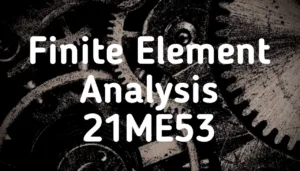
Finite Element Analysis 21ME53
Module 1`
Introduction to Finite Element Method: General steps of the finite element method. Engineering applications of finite
element method. Advantages of the Finite Element Method.
Potential energy method, Displacement method of finite element formulation. Convergence criteria, Discretization
process, Rayleigh Ritz method, Galerkin’s method (for study purpose only)
Types of elements: 1D, 2D and 3D, Node numbering, Location of nodes. Strain- displacement relations, Stress-strain
relations, Plain stress and Plain strain conditions, temperature effects.
Interpolation models: Simplex, complex and multiplex elements, linear interpolation polynomials in terms of global
coordinates 1D, 2D, 3D Simplex Elements.
Module 2
Introduction to the stiffness (Displacement) method: Introduction, One-Dimensional Elements-Analysis of Bars and
Trusses, Linear interpolation polynomials in terms of local coordinate’s for1D, 2D elements. Higher order interpolation
functions for 1D quadratic and cubic elements in natural coordinates, Constant strain triangle, Four-Noded Tetrahedral
Element (TET 4), Eight-Noded Hexahedral Element (HEXA 3 8), 2D iso-parametric element,
Numerical Problems: Solution for displacement, stress and strain in 1D straight bars, stepped bars and tapered bars
using elimination approach and penalty approach
Module 3
Beams and Shafts: Boundary conditions, Load vector, Hermite shape functions , Beam stiffness matrix based on Euler-
Bernoulli beam theory, Numerical problems on simply supported, fixed straight and cantilever beams, propped
cantilever beams with concentrated and uniformly distributed load.
Torsion of Shafts: Finite element formulation of shafts, determination of stress and twists in circular shafts.
Module 4
Heat Transfer: Basic equations of heat transfer: Energy balance equation, Rate equation: conduction, convection,
radiation, 1D finite element formulation using variational method, Problems with temperature gradient and heat fluxes,
heat transfer in composite sections, straight fins.
Fluid Flow: Flow through a porous medium, Flow through pipes of uniform and stepped sections, Flow through
hydraulic networks.
Module 5
Axi-symmetric Solid Elements: Derivation of stiffness matrix of axisymmetric bodies with triangular elements, Numerical
solution of axisymmetric triangular element(s) subjected to surface forces, point loads, angular velocity, pressure vessels.
Dynamic Considerations: Formulation for point mass and distributed masses, Consistent element mass matrix of one
dimensional bar element, truss element, triangular element, beam element. Lumped mass matrix of bar element, truss
element, Evaluation of eigen values and eigen vectors, Applications to bars, stepped bars, and beams.